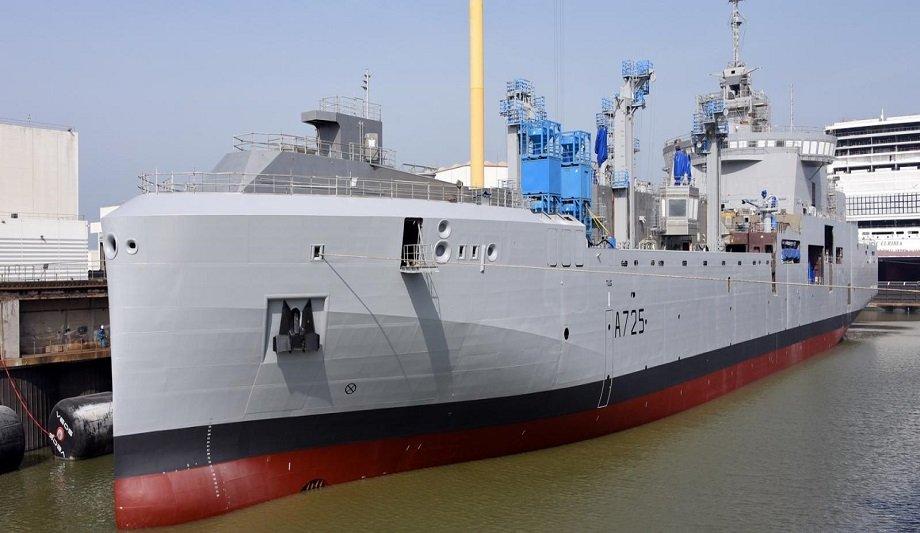The first of the four force replenishment vessels (BRF - Bâtiments Ravitailleurs de Force in French) of the FLOTLOG program was launched in Saint-Nazaire.
The Bâtiment Ravitailleur de Forces (BRF) Jacques Chevallier is the first of a series of four ships intended for the French Navy. The contract was awarded in January 2019 to Chantiers de l'Atlantique and Naval Group. The four vessels will be delivered successively until 2029.
FlotLog program
The FlotLog program is part of Franco-Italian cooperation led by OCCAR on behalf of the French Defence Procurement Agency (DGA) and its Italian counterpart NAVARM, within the Logistic Support Ship (LSS) program.
The BRF Jacques Chevallier was launched in Saint-Nazaire. The ceremony took place in the presence of Laurent Castaing, General Manager of Chantiers de l'Atlantique, Pierre Éric Pommellet, CEO of Naval Group, Matteo Bisceglia, Director of OCCAR, François Pintart, Director of Operations of DGA, and Admiral Xavier Baudouard, Commander of the French Naval Action Force.
Civilian ship benefits
Our industrial facilities enabled us to assemble the 20 blocks of the BRF Jacques Chevallier's hull in a record time of 50 days"
Laurent Castaing, General Manager, Chantiers de l’Atlantique said, “Our industrial facilities enabled us to assemble the 20 blocks of the BRF Jacques Chevallier's hull in a record time of 50 days," added Pierre Éric Pommellet, CEO of Naval Group.
"This demonstrates that our expertise as a manufacturer of civilian ships can greatly benefit the military in terms of time, cost, and quality control. Naval Group is proud to be once again present alongside Chantiers de l'Atlantique in this European program."
Sea trials
"This BRF, the first of a series of four ships, is a strong symbol of Franco-Italian cooperation. It is also new successful cooperation between Chantiers de l'Atlantique and Naval Group, which combine their skills to offer the DGA and the French Navy the best expertise in the civil and military sectors in the construction of ships of heavy tonnages."
The first sea trials will start in the second half of 2022, with the delivery of the first unit scheduled for the first half of 2023.
A strategic industrial partnership serving the French Navy
The design and construction of the four ships of the FlotLog program is the result of successful industrial cooperation between Chantiers de l'Atlantique and Naval Group, driven by OCCAR, in close collaboration with the DGA and the French Navy.
Chantiers de l'Atlantique carries out the global design and the construction of the four ships and ensures the integration and implementation of the embedded systems. Naval Group is responsible for the design, development, and integration of the combat system and the systems destined to receive aircraft and embark ammunition.
Logistical support
These tankers will participate to support missions for inter-allied operations
The BRFs, which will replace the French Navy's Durance-class ships, have a mission of logistical support of the combat vessels of the French Navy deployed as part of the naval air group or naval task groups. With a capacity of 13,000 m3, they carry fuel, ammunition, spare parts, as well as food for the vessels. These tankers will also participate to support missions for inter-allied operations, underlining the need for interoperable equipment.
As a true link in the fleet, these tankers will enable France to continue to have an ocean-going navy, capable of conducting long-term operations far from the national territory and thus maintaining its strategic autonomy.
Self-defence capacity
This new series of logistics fleet is equipped with self-defence capacities. The combat system of the four ships, whose architecture is based on the Naval Group’s Combat Management System, ensures the protection against close threats and the fight against asymmetric surface and air threats.
In line with international standards, the BRFs will replace the current tankers with increased capabilities and modern equipment to support the aviation group constituted around the aircraft carrier.
Jacques Chevallier features
The Jacques Chevallier, named after the naval engineer and father of French nuclear propulsion, will carry up to 31,000 tons at full load, making it the second heaviest ship in the French Navy, after the aircraft carrier Charles de Gaulle. It will be based in Toulon.
Main characteristics of the vessels:
- Full loaded displacement: 31,000 tons
- Overall length: 194 m
- Overall width: 27.60 m
- Crew capacity: 190 people, including 130 crew members and 60 passengers.
- Total deadweight: 14,870 tons
- Freight volume: 13,000 m3
- Total installed capacity: 24 MW





















